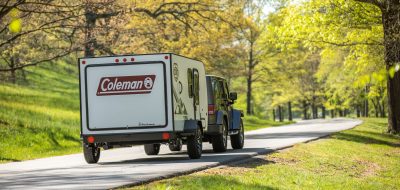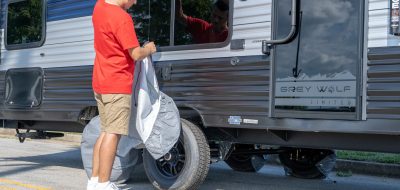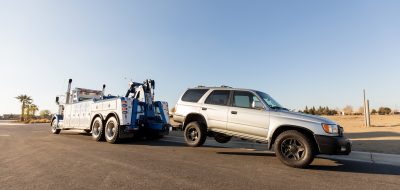 Tips courtesy of Good Sam Roadside Assistance
Tips courtesy of Good Sam Roadside Assistance
Most RV owners know how important it is to check our tires, yet only 14% of U.S. drivers properly check their tire pressure on a regular basis.* Proper tire care can prevent breakdowns, crashes, improve handling, give you better fuel economy and extend the life of your tires.
We know that accidents do happen and even the most safety-conscious RV owners get flat tires – even in their own garage! In fact,Good Sam Roadside Assistance discovered that 40% of disablements on autos and RVS were due to tire problems. To help get our members back on the road after a flat, Good Sam Roadside Assistance includes an essential benefit: Flat Tire Service.
If you have a tire problem while out on the road, a service technician will come out to replace the flat tire with your inflated spare. If you need a replacement, they will call our network of providers to find a proper replacement, have it delivered & install it on the spot so you can continue your travels. Service is available 24 hours a day and if no tires are available, Good Sam Roadside Assistance will tow your vehicle to the nearest professional service center (with no mileage limits). No other Roadside Assistance service offers a network that can “bring the shop to you.”
Don’t forget, household vehicles are also at risk for tire failure, and fortunately Good Sam Roadside Assistance covers all vehicles you own. Roadside Assistance combined with checking tire pressure and these other inspections can help you prevent tire troubles and trip interruptions. Before getting on the road:
1- Make sure all of the lug nuts are secure and your tire valves have valve caps.
2- Inspect tires for uneven wear patterns on the tread, cracks, foreign objects, or other signs of wear or trauma – pay particular attention to sidewalls for cuts or abrasions.
3- Remove bits of glass and other foreign objects wedged in the tread.
4- Set inflation pressures (Note: the amount of air pressure you need depends on the weight of your fully loaded vehicle. Use the vehicle’s recommended pressure, not the pressure indicated on the tire which is usually the MAXIMUM allowable pressure)
5- It is a good idea to own more than one tire pressure gauge. It is not uncommon for gauges to be off by several pounds.
6- Do not overload your vehicle. (Check the tire information placard or owner’s manual for the maximum recommended load for the vehicle).
7- It may seem like an inconvenience, but it is extremely important to get your loaded vehicle weighed before you leave.
8- If you are towing a trailer, remember that some of the weight of the loaded trailer is transferred to the towing vehicle.
9- Trailers should have the wheel bearings repacked after being in storage.
10-Consider nitrogen, an insert gas that is less affected by temperature. Make sure to use green valve stem covers so that you don’t accidentally re-fill with regular air!
Even with proper tire care, you never know what the road may bring. A tire replacement service as part of your roadside assistance plan can really minimize the burden on your trip.
*Study by the Rubber Manufacturers Association (RMA)
For more information on Good Sam Services, click here.





Bernie Beleskey
Re: Preventing Tire Problems
November 10, 2011 by Good Sam
http://blog.goodsamclub.com/2011/11/preventing-tire-problems/#respond
4- Set inflation pressures (Note: the amount of air pressure you need depends on the weight of your fully loaded vehicle. Use the vehicle’s recommended pressure, not the pressure indicated on the tire which is usually the MAXIMUM allowable pressure)
Reply:
This referes to a Motorhome or Tow unit, not trailers. According to all Tire manufactures and the RMA 5th wheel and trailers need, because of their design, to have the maximum or near maximum at cold air pressure.
Trailer tire are more flexable on the side wall and thus allow for safer cornering. Thus minimizing tire separation on cornering
Plus a tire at a lower presurer will heat up sooner and increase rolling resistance. An under inflated tire last longer and have reduced braking control, as well.
Wil Painter
David:
Tire pressures are set cold.
Driving (rolling resistance), solar gain (sun vs shade), and rising air temperature all increase the tire’s temperature. On my race car, I’m always setting them first thing in the morning before any of those effects create a variable so I can achieve repeatable results. Do not bleed them down as the day goes on.
As winter approaches (it’s here where I live), you’ll find that your previously set summer pressures will have dropped, by something like1 psi per 10 degrees, so you could easily be down 5 psi just ’cause it’s cold.
Happy Motoring!
Wil
Bill Mevers
Where Do I find the correct tire pressure for varies #’s of load? If my 5th wheel has a load of x# on one tirp and Y#s on another, what would be the correct pressures for the same tire?
Scott Pickens
I recently returned from a 5900 mile journey of the 7 western states. A tire blew out on my 5th wheel trailer. I called Good Sam, they were there in less than 20 minutes. They pulled my spare replaced the bad tire and brought me a new spare. I was back on the road in less than 40 minutes. Good Sam rocks. I will renew for the rest of my traveling days.
David
Regarding tire pressure:
1) Given: Properly set “undriven” tire pressure.
2) Inquiry: On an “hot” day, and/or “under load” after checking initially for “proper tire pressure” as well as finding it “normal”; Do I release tire pressure at a “rest stop” should for some reason the guage register pressure ABOVE the “proper tire pressure” (cold, as when starting out in the morning) later in the day at the “rest stop” location?
3) I’ve wondered about this question many times in vehicles I’ve (versus my wife) have driven for many miles.
4) Any response from someone “knowledgeable” would be greatly appreciated by this communicant.
5) Thank You very much for the response.